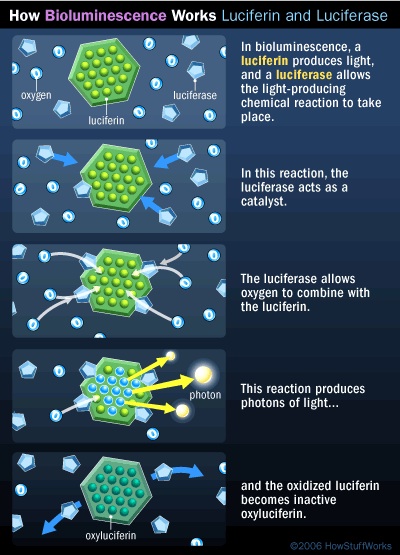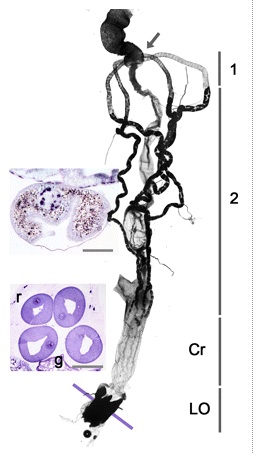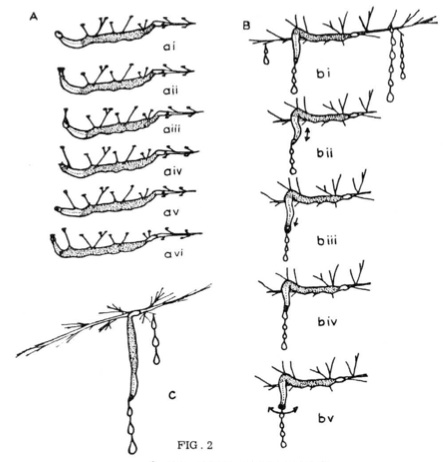Bioluminescent Lures
Biology 342 Fall 2012
Emily Agan, Christina Barrett
Mechanism of Processes in A. luminosa
 |
| This graphic shows a simplified progression of a luciferin-luciferase system, which is what A. luminosa uses to produce light. Sourced from Tracy V. Wilson |
The gentle glow of Arachnocampa luminosa is an example of bioluminescence, or the production of light by a living creature. Bioluminescence is common in creatures that live in dark places, such as in caves or the bottom of the ocean.
The light these animals produce can be used for many things, including mate attraction, prey attraction, a form of communication.
Though not all organisms that bioluminesce use the same system, the method of producing bioluminescence, for A. luminosa, is a luciferin-luciferase system. Fireflies also use this system at night to communicate and locate a mate, but bacteria utilize a different method, aLux system, to produce light.
In such a process, a luciferin, or light-producing molecule, and a luciferase, an enzyme that assists in the light production, react to sustain and propagate light. Adenosine triphosphate (or ATP) supplies the necessary energy (Rigby, 2011).
Glowworms can
- Control their bioluminescence
- Produce light at any given time
- Begin glowing just after they have hatched
- Cease production of light when disturbed by light or loud noise
- Retain bioluminescence after the larval period if they are female
- Utilize their post-larval luminescence to attract mates

In their larval stage, Arachnocampa luminosa produce light from an organ located in their last abdominal segment. These light-producing organs arise from the Malpighian tubules, which are tubules involved in excretion and osmotic regulation (Rigby, 2011).
This figure shows the Malpighian tubules, cryptonephridial region and light organ of Arachnocampa flava.
- The arrow indicates where the four Malpighian tubules originate.
- The numbers 1 and 2 refer to regions anterior to the light organ, which are not involved in light production.
- Cr indicates the arrangement of the cryptonephridial region.
- The light organ is indicated by the tag "LO", and is dark because the scanner the experimenters used scattered the light produced by the organism.
- The top inset is a cross-section of a Malpighian tubule, and the bottom inset is a cross-section of the light organ, with r indicating the reflector, which sends light out of the organsim, and g designating the gut.
 |
| This diagram indicates the way in which A. luminosa constructs its nest. In the drawings labeled "a", the glowworm emits secretions from its mouth, attaching them to the cave ceiling and then sliding the secretions along its body to move forward. It leaves a a hollow nest behind it. In part "b", the glowworm produces its mucous lures, and in part "c", the glowworm is retracting its lure. Sourced from I. A. N. Stringer, 1967 |
Bioluminescence, for A. luminosa, is a type of feeding strategy. Many animals are naturally attracted to light, and A. luminosa exploits this.
When another cave-dwelling insmct flies toward the light produced by A. luminosa larvae, they are trapped in another of A. luminosa’s deadly features. Aside from the bait of bioluminescence, these glowworms are equipped with deadly lures, which they begin to lower shortly after pupation.
The larvae create their own nests by shaping its own secretions into a long “hallway” which hangs from the cave ceiling, supported by secretions hardened into threads. The lures are part of the nest, a type of fishing line that extends to about 10 cm in length. Along the thread are several sticky drops of mucus. When the larva creates the thread, it secretes a droplet every 15 to 18 seconds, with the first drop being the largest (Stringer 1967).
Once an insect has been caught in the trap, its thrashing distorts the nest shape. This mechanical stimulation , as well as chemical cues secreted by the insect, alerts the glowworm that the contents of the net are edible. The larva will pull the thread back up and bite its prey, killing it quickly. It may suck out the juices, leave the prey for storage, or eat the entire insect.
There are many more complex processes at work in A. luminosa, but some of the most interesting ones are represented here.